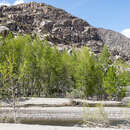Associations
provided by BioImages, the virtual fieldguide, UK
Plant / resting place / within
epiphyllous, subepidermal, grouped, confluent telium of Melampsora laricis-populina may be found in dead, fallen leaf of Populus laurifolia
Comments
provided by eFloras
Used for fuel, wood pulp, and making farm tools.
- license
- cc-by-nc-sa-3.0
- copyright
- Missouri Botanical Garden, 4344 Shaw Boulevard, St. Louis, MO, 63110 USA
Description
provided by eFloras
Trees to 15 m tall; bark grayish, darkened and furrowed toward base of trunk; crown wide. Sprouts and branchlets yellowish, angled, tomentose or rarely glabrous. Buds conical, very viscid; basal scales tomentose. Leaves of short branchlets with leaf blade elliptic, ovate, or oblong-ovate, 6-12 × 4-7 cm, base rounded or cuneate, margin crenulate, ciliate, apex acute or shortly acuminate. Leaves of sprouts with petioles terete, 2-5 cm, adaxially canaliculate, tomentose; leaf blade lanceolate or ovate-lanceolate, 10-15 cm. Male catkin 3-4 cm; bracts suborbicular, 3-5 mm, usually caducous, base cuneate, margin laciniate, with brown lobes. Male flower: stamens 30-40; anthers purplish red. Female catkin 5-6 cm, elongated in fruit; rachis tomentose. Capsule ovoid, 5-6 mm, glabrous or pilose, 2- or 3-valved. Fl. Apr-May, fr. Jun.
- license
- cc-by-nc-sa-3.0
- copyright
- Missouri Botanical Garden, 4344 Shaw Boulevard, St. Louis, MO, 63110 USA
Distribution
provided by eFloras
Nei Mongol, Xinjiang (Altay Shan, Tacheng Diqu) [NW Mongolia, Russia]
- license
- cc-by-nc-sa-3.0
- copyright
- Missouri Botanical Garden, 4344 Shaw Boulevard, St. Louis, MO, 63110 USA
Populus laurifolia: Brief Summary
provided by wikipedia EN
Populus laurifolia, the laurel poplar, is a species of flowering plant in the family Salicaceae, native to Kazakhstan, the Altai, Mongolia, and Xinjiang in China. It hybridizes readily with other species of poplar, and has high genetic variation.
- license
- cc-by-sa-3.0
- copyright
- Wikipedia authors and editors

